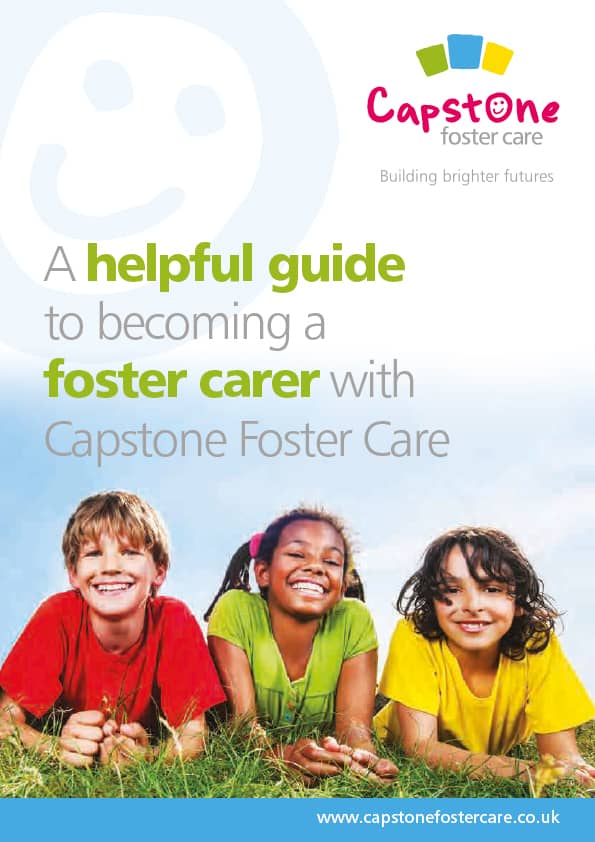


Fostering a disabled child
The role of an independent fostering agency
Can I choose who I foster?
How to foster
What are the benefits of fostering with an independent fostering agency?
What happens when a child is taken into care?
Fostering process: what happens on an initial home visit?
Can you foster if you have mental health issues?
Fostering with local authority vs independent agency
Interview: Life as a foster parent during the pandemic
Becoming A Foster Carer
Benefits of becoming a foster parent
What is a Care Leaver?
What is a Foster Carer?
What is Foster Care?
Do I become a Foster Carer?
Fostering Regulations
How much do Foster Parents get paid?
How to Foster a Child
How long does it take to become a Foster Carer?
How to foster – everything you ever wanted to know
Facts about Foster Care
What are the Foster Care requirements?
Foster Care Handbook
Foster Carer Job Description
Changing IFA - Transferring to Capstone
Fostering Definition
Foster Care Statistics
Fostering Assessment
Fostering Outcomes
Fostering Stories
Fostering Children UK
Children needing Fostering
8 reasons why a child may be taken into care
Fostering as a Career
Looked after Children
Top transferable job skills to become a foster carer
Fostering as a same sex couple
Fostering while renting
Can I foster if...?
Mythbusting the top 10 Foster Care Myths
Can I foster if I am disabled?
LGBT Fostering Mythbusting
Can I foster if I have pets?
Can I Foster A Child?
Can you Foster and Work?
Can you Foster with a Criminal Record
Fostering as a Single Parent
LGBT Family and Foster Care
Fostering across Cultures
Muslim Fostering
Christian Foster Care
Sikh
Empty Nest Syndrome and Foster Care
10 things you can do when your Children fly the nest
Can I Foster?
Fostering Babies - Myths
Focusing on Parent & Child Fostering
Fostering Siblings
Fostering Teenagers
Fostering Teenagers - Breaking down the Myths
Fostering Unaccompanied and Asylum Seeking Children
Mother and Baby Foster Placements
Private Fostering
Therapeutic Fostering - Multi-disciplinary Assessment Treatment & Therapy Service (MATTS)
Young Children Fostering Placements
Difference between short and long-term fostering
How to prepare a child for becoming a care leaver
Children who foster: impact of fostering on birth children
How to prepare your home for a foster child
10 tips for foster children’s education
How to prepare your foster child for secondary school
Tips for coping when foster placements end
Tips for foster parents during Coronavirus
What happens if foster parents get divorced?
5 ways to manage Mother’s Day with foster children
Tips for managing foster children’s bedtime routines
How to handle foster child bullying
Fostering allowances and the gender pay gap
Tips for keeping foster children safe online
How to adopt from Foster Care
5 ways to manage Father’s Day with foster children
8 most common fostering challenges
Supporting foster children’s contact with birth families
How to deal with empty nest syndrome
How to recognise signs of depression in foster children
Can you take a foster child on holiday?
Tips and advice on fostering with a disability
10 tips on connecting with your Foster Child
Fostering versus Adoption - What's the difference?
How Fostering can change a future
How to adopt from Foster Care
How to encourage children to read in Foster Care
How to prepare a Foster Child's bedroom
Online grooming - unwanted contact and how to identify it
Reading and storytelling with Babies and young Children
Supporting Children's Learning
Technology and Internet Safety advice
The 20 most recommended books Foster Carers and young people should read
The impact of early childhood traumas on adolescence and adulthood
Tips for coping with attachment disorders in Foster Children
Tips for supporting reunification in Foster Care
Together for a better Internet - Web Safety for Foster Children
What is sexual abuse and sexual violence
Foster Child behaviour management strategies
Foster Parent Advice: What to expect in your first year of fostering
Capstone's twelve tips at Christmas
10 celebrities who grew up in Foster Care
Celebrating our Children and Young People
Could Millenials be the solution to the Foster Care crisis?
Do you work in Emergency Services?
Form F Assessor and Assessment Training
Foster Care Fortnight
Improving Children's Welfare - Celebrating Universal Children's Day
It's time to talk about Mental Health and Foster Care
New Year - New Career - Become a Foster Carer
Promoting the rights and wellbeing of persons with Disabilities
Refugee Week
Young people and Mental Health in a changing world
Young People Charities
As a foster parent, you are in the role of a parent but ultimately, the local authority and the child’s birth parents have responsibility for the child, though you may share some decision-making capabilities. However, when you adopt a child, you have full parental responsibility – and the child is a permanent member of your family.
So, should you choose to foster or adopt? Let’s look at the differences between being assessed and approved as a foster parent and an adoptive parent.
If you’re interested in learning the difference between adoption and fostering, it’s important to gain an understanding of the requirements for each approach.
Of course, there is a lot more to the approval processes – but looking at the bare bones of each process makes it easier to compare the two approaches:
Foster parent approval
There are five requirements to be approved as a foster carer:
Adoption approval
The two-part adoption assessment process
The goal of the two-part process is to help would-be adopters get ready to apply to adopt in six months’ time. The first part involves learning about what adoption entails as well as giving the adoption agency time to check each applicant’s references. This takes about two months.
The second part takes about four months and is an extension of the assessment process, during which the potential adopters are prepared for the application process.
So, how do you know whether fostering or adoption is the right path for you? In many ways, both have similar processes. People wanting to step into the role of caring for children who may have been left vulnerable and traumatised must be aware of the changes this will make in their own lives. They also have to be deemed able to care for, love, and look after the child in a way that will create a positive life experience.
Demand
One major difference between fostering and adoption is that of demand. There are approximately 75,000 children and young people in foster care in the UK. Of these, 6,800 need a foster home. Because there is a shortage of foster carers across the country, these 6,800 children are in a very precarious situation.
It is not possible to crowd them all into approved foster homes. It is stressful and frightening for young people who have been removed from their families without having to wait for a foster home.
On the other hand, there are about 6,000 children in need of adoption every year.
When you are approved as a foster carer, your first placement is likely to take place quite quickly – and the situation is similar when an adopter is approved. This is because there are more foster children who need a home as soon as possible however, there is a better chance of having a placement who matches the carers’ preferences and skills.
It also should be noted that adopters may not find a suitable match as quickly. If a match in your geographical area is not found within a three-month period, your information goes to the National Adoption Register. The National Adoption Register matches children waiting to be adopted with approved adopters.
Chances are that when you make the decision to adopt, you have a preconceived notion of the child you will welcome into your family. During the assessment and evaluation period, you learn about the adoption process and this will challenge those notions. For example, in 2019, the average age of a child being adopted tends to be of school age and often there are sibling groups that need to be adopted.
In your initial consideration of becoming adoptive parents, you may have thought about who the children are that need adopting. Even so, you might be surprised to learn that many have been taken from their birth families because of abuse or neglect and that medical issues, learning disabilities, and behavioural problems are all too common.
Over your six months in the assessment process, you may find that you have to adjust your thinking about the child you are prepared to adopt and change the age range. You may also have to think about what medical challenges or disabilities you have the ability and skill to work with.
Adoption is a serious commitment. When the child becomes your child, you are the parent. This is a forever deal. Second-goes are not acceptable. The repercussions are legal, social, and emotional. While there is a period of time after the child is placed with you and before the adoption order is made when you have agency support, ultimately, this is your new family unit.
In fostering, your home is the child’s temporary home as the first approach is to help the birth family find a solution to their negative situation so that the child is able to go back to his or her family home. Sometimes, the child’s relatives are able to take the child into their home, while other outcomes involve permanent fostering or adoption.
Foster parents have a supervising social worker available at all times to help with any problems or concerns. They also receive an allowance that covers the cost of caring for the child. If the child has special needs, the foster parents reach out to the fostering agency for financial coverage to meet these needs.
Adoption allowances are means-tested – this means that some adoptive parents will not be eligible for adoption allowance. The maximum adoption allowance is decided in relation to the fostering allowance that would otherwise be payable for that child. As adoptive parents, you are entitled to an assessment of needs for your adopted child – however, there is no entitlement to funding for therapeutic or other services to meet those needs.
The cost of adoption
While foster carers are provided a weekly allowance per child, adoption can be costly.
The application process to adopt with the Independent Adoption Panel has a price tag of between £4,000 and £9,000. In addition, you need to pay the Department of Education £885 to process your application and provide your Certificate of Eligibility. If your income exceeds £45,000, this fee goes up to £1,775.
Part of the assessment process involves the agency learning about your financial status. It is important that when you adopt a child, you are able to provide the security the child deserves. If you do not already have children, it may surprise you to learn just how much it costs to raise a child.
Who can be adopted?
There are two requirements for a child to be adopted:
Both the child’s natural mother and father must consent to the adoption. There are circumstances when this consent can be waived. For example, if the parents cannot be found, are incapable of giving consent, or the child is at risk unless they are adopted, then the birth parents’ consent is not required.
Many of the children in the UK who are available for adoption emerge from the foster care system. There are several types of foster care:
Long-term fostering is also known as permanent fostering. Young people are rarely placed in permanent care from the onset of being fostered as, when they are taken into care, the expectation is that they will return home once the problems in their birth family are resolved.
It is only when the situation cannot be remedied that a court order is issued. This court order gives the local authority legal responsibility for the young person and, as the child’s guardian, the local authority must find a permanent home for the child. In some, but not all, cases, this means that the child is available for adoption.
The alternative is long-term fostering and the question is, why is long-term foster care chosen over adoption? This is because it may be deemed in the child’s interest to keep in contact with, and visit, his or her birth parents. Often, this is because of the child’s strong desire to maintain contact with his or her family.
The contact might be limited but it allows for a connection between the child and the birth parent or parents. If the child were adopted, the adoptive parents have exclusive parental rights and any link between the child and the birth parents would be severed.
The goal of fostering is not adoption. Fostering as a path toward adoption does not work very well, although it does happen. Typically, foster children do not become available for adoption. If you do foster a child who becomes adoptable, there are a couple of issues that you need to contend with.
First of all, being approved as a foster carer is not the same as being approved as an adoptive parent and so you will have to go through the approval process to adopt. Also, going from fostering to adoption can complicate the process of severing the birth parents’ link to the child – this is because, as a foster parent, the birth parents know who you are.
There is “Fostering for Adoption” where children in care are being assessed with a view to adoption as an outcome. Potential adopters may foster the child while the decision is being made as this protects the child from being moved and moved again.
This happens when the local authority or fostering agency takes a look at the approved adopters and accepts them as temporary foster carers for the child. This is referred to as dual approval. The dual approval family are treated as foster carers, which means that the local authority and birth family have parental responsibility. The foster carers are paid a fostering allowance. Adoption is not guaranteed however and there is the risk of the final decision not being that the child will be adopted.
Concurrent planning
Concurrent planning is similar to fostering for adoption in that the potential adopter fosters until the decision is made about the child’s future. Concurrent planning refers to babies and toddlers under the age of two and the same approach as with fostering for adoption holds true.
The concurrent carer is a foster carer while the decision is being made, and as such must work with the birth parents during the assessment. If the court decides that adoption is the best solution, the child stays with the concurrent carer who is then able to adopt the child.
Whether to foster or adopt is a difficult decision. It involves so many elements of your life. There are financial considerations. Foster parents are fully supported by the local authority or agency with whom they work. An independent fostering agency such as Capstone has a nationwide team of experts who are available to assist with special needs, behavioural problems, and learning disabilities.
You are not alone in your efforts to remain patient and supportive of your foster child. There is a strong network of carers as well with whom you can share experiences.
The greatest difference is between the number of children and young people who need you, indicating that as a foster carer you can help many children, where as an adoptive parent, you might look for a long time to find a child that is a good solid match to be a permanent member of your family.
Still need help deciding, or want to know more information about the difference between fostering and adoption? Get in touch with a member of our helpful team here at Capstone Foster Care.
If you’ve got any questions or would like to find out more about fostering with Capstone, fill out the form below.
An experienced fostering advisor from your local area will then be in touch.

Start the conversation today. Our team of friendly advisors are on hand to answer any foster care questions you may have. We can offer you honest and practical advice that can help you decide if becoming a foster carer is the right path for you.


